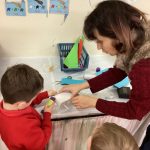Rationale
At Millbrook primary school we believe that Design Technology encourages a child’s creativity, critical thinking and problem-solving whilst also developing a range of key practical skills. We believe it to be an inspiring, rigorous and practical subject where children can individually and collaboratively solve real life, relevant problems.
We have designed a curriculum whereby our children will consider the user, the purpose and functionality of their creations, will make design decisions, innovate and evaluate their work. Our curriculum embodies 3 threshold concepts:
- Master practical techniques. This concept involves developing the skills needed to make high-quality products.
- Take inspiration from design. This concept involves appreciating the design process that has influenced the products we use in everyday life.
- Design, make, evaluate and improve. This concept involves developing the process of design thinking and seeing design as an iterative process
Our curriculum covers the skills defined in the National Curriculum by planning for progression in knowledge, skills and vocabulary.
“Design and technology is an inspiring, rigorous and practical subject. Using creativity and imagination, pupils design and make products that solve real and relevant problems within a variety of contexts, considering their own and others’ needs, wants and values. They acquire a broad range of subject knowledge and draw on disciplines such as mathematics, science, engineering, computing and art. Pupils learn how to take risks, becoming resourceful, innovative, enterprising and capable citizens. Through the evaluation of past and present design and technology, they develop a critical understanding of its impact on daily life and the wider world. High-quality design and technology education makes an essential contribution to the creativity, culture, wealth and well-being of the nation.”
National Curriculum 2013
We have used the Chris Quigley Curriculum Companion as the backbone of our DT curriculum mapping and planning. We have mapped our curriculum to address the needs of our children and adapt this as our cohorts move through the school, taking account of our split year groups. Staff have created their own unit plans using the underpinning threshold concepts from Chris Quigley alongside their subject knowledge and needs to their children.
Aims
The National Curriculum for Design Technology aims to ensure that all pupils:
- develop the creative, technical and practical expertise needed to perform everyday tasks confidently and to participate successfully in an increasingly technological world
- build and apply a repertoire of knowledge, understanding and skills in order to design and make high-quality prototypes and products for a wide range of users
- critique, evaluate and test their ideas and products and the work of others
- understand and apply the principles of nutrition and learn how to cook.
Teaching and learning style
The teaching and learning in our Design and Technology curriculum helps to give pupils the knowledge, skills and understanding they need in order to meet the above aims.
Pupils will be equipped with technical knowledge, practical knowledge, design inspiration and design process skills.
Key knowledge and skills for DT have been mapped across the school to ensure progression between year groups. Children will be given opportunities to take inspiration from real life design, practise skills for ‘finger fluency’, design and apply new techniques, test, rethink and evaluate the finished product.








